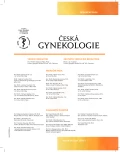Urinary incontinence during pregnancy
Authors:
P. Vašek; M. Gärtner; O. Szabová; M. Juráková
Authors‘ workplace:
Gynekologicko-porodnická klinika OU a FN, Ostrava, přednosta doc. MUDr. O. Šimetka, Ph. D., MBA
Published in:
Ceska Gynekol 2019; 84(1): 73-76
Category:
Overview
Objective: An overview of urinary incontinence issues during pregnancy.
Design: A review article.
Setting: Department of Gynekology and Obstetrics, University Hospital Ostrava.
Conclusion: Mechanisms leading to stress incontinence are multifactorial. Pregnancy and childbirth can lead to injuries or drowsiness of the pelvic floor muscles. The age of the firstborn and BMI in the pelvic floor disorders is similar to that of the end of pregnancy.
Keywords:
pregnancy – urinary incontinence – pelvic floor
Sources
1. Al-Mukhtar Othman, J., Akervall, S., Milsom, I., et al. Urinary incontinence in nulliparous women aged 25-64 years: a national survey. Amer J Obstet Gynecol, 2017, 216, p. 149–159.
2. Bazi, T., Takahashi, S., Ismail, S., et al. Prevention of pelvic floor disorders: international urogynecological association research and development committee opinion. International Urogynecol J, 2016, 27, p. 1785–1795.
3. Carvalho de Araujo, C., Coelho, SA., Stahlschmidt, P., et al. Does vaginal delivery cause more damage to the pelvic floor than cesarean section as determined by 3D ultrasound evaluation? A systematic review. International Urogynecol J, 2018, 29, p. 639–645.
4. Cosimato, C., Cipullo, LMA., Troisi, J., et al. Ultrasonographic evaluation of urethrovesical junction mobility: correlation with type of delivery and stress urinary incontinence. Intern Urogynecol J, 2015, 26, p. 1495–1502.
5. Eason, E., Labrecque, M., Marcoux, S., et al. Effect of carrying a pregnancy and of the method of delivery on urinary incontinence: a prospective cohort study. BMC Pregnancy Childbirth, 2004, 4, p. 4.
6. Huvar, I. Močová inkontinence v těhotenství, Urol praxi, 2014, 15, 4, s. 152–154.
7. Howard, D., Makhlouf, M. Can pelvic floor dysfunction after vaginal birth be prevented? Intern Urogynecol J, 2016, 27, p. 1811–1815.
8. Jelovsek, JE., Chagin, K., Gyhagen, M., et al. Predicting risk of pelvic floor disorders 12 and 20 years after delivery. Amer J Obstet Gynecol, 2018, 218, p. 222.e1–222e19.
9. Juráková, M., Huser, M., Szabová, O., et al. Chirurgická léčba stresové inkontinence moči u žen – od jehel až k (mini)pásce. Čes Gynek, 2017, 82, 1, s. 65–71.
10. Martan, A., et al. Nové operační a léčebné postupy v urogynekologii, druhé, rozšířené a přepracované vydání. Praha: Maxdorf, 2013, s. 50–53.
11. Martan, A., Mašata, J., Švabík, K. Management recidivující stresové inkontinence moči po selhání efektu anti-inkontinentních operací. Čes Gynek, 2017, 82, 1, s. 59–64.
12. Martan, A., Drbohlav, P., Halaška, M., et al. Změny uložení uretry a hrdla močového měchýře v těhotenství a po porodu. Čes Gynek, 1996, 61, 1, s. 35–39.
13. Mulder, FEM., Hakvoort, RA., Schoffelmeer, MA., et al. Postpartum urinary retention: a systematic review of adverse effects and management. Intern Urogynecol J, 2014, 25, p. 1605–1612.
14. Rortveit, G., Daltveit, AK., Hannestad, YS., et al. Vaginal delivery parameters and urinary incontinence: The Norwegian EPINCONT study. Amer J Obstet Gynecol, 2003, 189, p. 1268-1274.
15. Rortveit, G., Daltveit, AK., Hannestad, YS, et al. Urinary incontinence after vaginal delivery or cesarean section. New Engl J Med, 2003, 348, p. 900–907.
16. Rušavý, Z. Poruchy pánevního dna po porodu. Acta Med, 2016, 4, s. 31–32.
17. Ryšánková, M. Klasifikace inkontinence moče u žen. Klasifikace prolapsu pánevních orgánů. Urol praxi, 2016, 17, 2, s. 72–74.
18. Schwertner-Tiepelmann, N., Thakar, R., Sultan, HA., et al. Obstetric levator ani muscle injuries: current status. Ultrasound Obstet Gynecol, 2012, 39, p. 372–383.
19. Švabík, K., Martan, A. Těhotenství, porod – poruchy pánevního dna a inkontinence moči. Mod Gyn Por, 2003, 12, 1, s. 37–45.
20. Texl, J., Huser, M., Belkov, I., et al. Výsledky operační léčby stresové inkontinence moči mini-invazivní transobturatorní páskou z jedné incize. Čes Gynek, 2015, 80, 5, s. 345–350.
21. Urbánková, I., Hympánová, L., Krofta, L. Ovce jako experimentální model pro studium vlivu těhotenství, porodu a operačních technik na pánevní dno. Čes Gynek, 2017, 82, 1, s. 54–58.
22. Vaverková, A., Kališ, V., Rušavý, Z. Informovanost rodiček v oblasti primární a sekundární prevence poruch pánevního dna po porodu. Čes Gynek, 2017, 82, 4, s. 327–332.
23. Volløyhaug, I., Mørkved, S., Salvesen, Ø., et al. Forceps delivery is associated with increased risk of pelvic organ prolapse and muscle trauma: a cross-sectional study 16–24 years after first delivery. Ultrasound Obstet Gynecol, 2015, 46, p. 487–495.
24. Wilson, D., Dornan, J., Milsom, I., et al. UR-CHOICE: can we provide mothers-to-be with information about the risk of future pelvic floor dysfunction? International Urogynecol J, 2014, 25, p. 1449–1452.
25. Woodley, SJ., Boyle, R., Cody, JD., et al. Pelvic floor muscle training for prevention and treatment of urinary and faecal incontinence in antenatal and postnatal women. Cochrane Database of Systematic Reviews 2017, Issue 12. Art. No.: CD007471. DOI: 10.1002/14651858.CD007471.pub3.
Labels
Paediatric gynaecology Gynaecology and obstetrics Reproduction medicineArticle was published in
Czech Gynaecology

2019 Issue 1
Most read in this issue
- Endometriosis in pregnancy – diagnostics and management
- Diagnostics and modern trends in therapy of postpartum depression
- Cervical cerclage – history and contemporary use
- Uterine microbiome and endometrial receptivity
